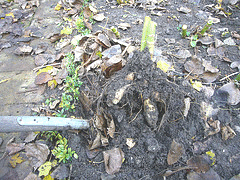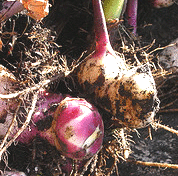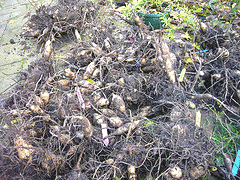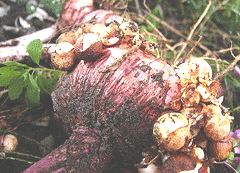Storing Tender Bulbs
Bulbs that are not hardy in your zone must be dug up and stored, the replanted for the next bloom season
Overwintering Tender Bulbs Tuberous Root Perennials
These would include Dahlias, Cannas, Calla, 4 o’clocks, Gladioli and Caladium, as well as tuberous root begonias. Winter protection in the garden is not possible. These rootballs need to be properly stored inside over the winter. Not an easy task, I have tried storing Cannas, only to have them rot. Unfortunately, these are not inexpensive to replace each year, but for the perfect accent in a bed, it may be worthwhile. Following are basic storage methods, but you will find that there are many different ideas out there. What works for each individual gardener may have something to do with conditions in their storage area - light, moisture, and temperature. Storing tender perennials may take a little experimentation.
Most gardeners will agree on the basics, beginning with: Wait for the foliage to all turn yellow, then dig up the bulbs or root balls carefully. Cut off foliage and brush off loose soil. For plants with corms, such as gladioli, separate the corms and discard old shriveled corms. Then place in a warm dry place to dry them out. If you try to dry them outside, rain will continually delay the drying process. The garage may get cool at night, but will just slow down the process. If you can, drying them indoors will be most efficient.
To pack the bulbs for storage: When the bulbs or tubers are dry, gently brush off excess soil being careful not to bruise them. Dust with an all purpose garden pesticide with fungicide. If you don’t have many bulbs to store, hang them in paper bags from hooks on a wall or ceiling. Larger quantities of bulbs can be stored on screen bottomed. Layer only 2 or 3 deep to keep good air circulation. Most gardeners store their bulbs in a container layered with peat moss, vermiculite, perlite, cocoa hulls or sawdust. Store in a cool, but frost free spot until spring. The garage will often get too cold in the northern zones, and even an unheated basement may get too warm for some types. If you have anything resembling a root cellar, that might be the best. Perhaps a storage closet along an outside cement wall in the basement. If you are not sure, test your location with a thermometer this winter and check it frequently. Many bulbs and roots will store well at 60 degrees, some up to 68 degrees. But as noted below, most will do better with colder temperatures. The packing material you use will help keep the temperature of your bulbs a bit more stable. And NEVER store your bulbs and roots with apples or other fruits! Ripening fruit produces ethylene gas.
Caladium - Dig up before frost and dry in a warm place for a week to ten days. Then store following the instructions above. Best storage temperature is 60 degrees. Some gardeners prefer to store caladium with the soil left on the bulb. The bulb clumps may then be stored as above Wash the soil from the bulbs in spring just before planting and separate bulbs as needed.
Canna - Dig out after a hard frost. Cut the tops back to about 3 or 4 inches. Air dry in a warm place for a week or two. Store in an empty shallow box (this I haven’t tried yet - not packed into any medium). Many gardeners pack in one of the mediums mentioned above. Like Caladium, Canna may also be stored with the soil in place and washed and separated in spring. Best storage temperature is 45 - 50 degrees.
Dahlia - Just about every Dahlia grower will give you a different storage method. You just need to find what works for you. After the first light frost cut back to a few inches. Lift these plants out carefully, leaving as much soil intact with the root ball as possible. Only allow to air dry a few hours, then pack following instructions above. Method 2: After gently removing from the ground, hose off all soil. Place in a plastic bag with holes for ventilation, packed with one of the above mediums. Store in a covered plastic container to keep dark, fill the container with crumpled newspaper. Method 3: Store in a slightly moistened peat moss. Check frequently throughout the winter - if peat moss has dried out, moisten again. Best storage temperature is 35 - 40 degrees.
Gladiola - Dig up after frost when the foliage is fading. Save even the smallest corms, they will grow large when you plant them next spring and eventually produce a flowering plant. Allow to dry up to four weeks in a warm, dry place with good circulation. About 75 - 80 degrees is best for curing the corms. Then they need to be stored a little differently then mentioned above. Find a dry, cold place, about 35 -40 degrees. Hang them from the wall or ceiling in open mesh bags for good circulation - use an old onion bag, nylon stockings, or a lingerie washing bag
Tuberous Begonia - Dig up before frost and cut the foliage back to a couple of inches. Dry the roots for two to three weeks in a warm place. Store following the instructions above. Best storage temperature is 45-50 degrees. Begonia may also be stored with soil in place.



